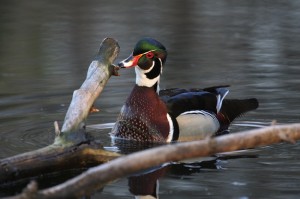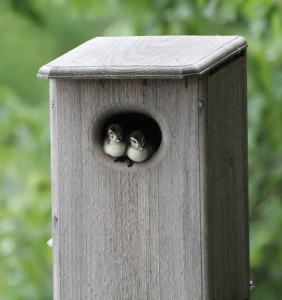Wood duck box installation and maintenance
By Justin Brock, Wildlife Biologist, Division of Wildlife and Freshwater Fisheries
 Wood ducks are commonly seen on Alabama’s marshes, swamps and other wetland areas. This duck is perceived by many to be one of the most beautiful species in North America and is a favorite of waterfowl hunters. Fortunately for the residents of Alabama, the wood duck can also do something that most duck species do not – call Alabama home year-round. The wood duck is one of the few waterfowl species found throughout the year in Alabama. Because of this, Alabama landowners can have a greater impact on wood ducks than on other waterfowl species that may only spend the winter months in the area, or just simply pass through on their way south.
Wood ducks are commonly seen on Alabama’s marshes, swamps and other wetland areas. This duck is perceived by many to be one of the most beautiful species in North America and is a favorite of waterfowl hunters. Fortunately for the residents of Alabama, the wood duck can also do something that most duck species do not – call Alabama home year-round. The wood duck is one of the few waterfowl species found throughout the year in Alabama. Because of this, Alabama landowners can have a greater impact on wood ducks than on other waterfowl species that may only spend the winter months in the area, or just simply pass through on their way south.
There are many factors to consider when managing a property for wood ducks. The ducks need an environment that provides the right amounts of food, cover and water to survive. However, the amount of quality nesting cavities is sometimes overlooked. In many areas, there are not adequate numbers of mature trees due to logging or other activities to provide natural nest cavities. In such areas, the construction of wood duck boxes may be a needed management strategy.
The U.S. Fish and Wildlife Service first used wood duck boxes in 1937. Since that time, they have been used on numerous properties to increase local populations of wood ducks. Boxes should be placed in any habitat that has enough food and cover, but does not provide enough natural nesting cavities. Once an area has been identified, the number of boxes needed and the location of each box must be determined.
Start small when first putting wood duck boxes in an area. Place only the number of boxes that can be maintained annually. The recommended number of boxes is one per acre of suitable habitat, with the boxes spaced at least 55 to 110 yards apart. Once 50-80 percent of these boxes are being used, more may be added if they can be maintained.
Opinions differ on how much to conceal the boxes. Research shows that boxes placed in areas that are more concealed with dense vegetation are less susceptible to becoming a dump nest (i.e., nests where multiple ducks lay eggs and cause the nest to be abandoned). However, nests located in open areas tend to be more productive, even though they may have a higher chance of becoming a dump nest. Therefore, it is recommended boxes be placed in open areas. Nest boxes should be observed to determine nest success.
 Ideally, nest boxes should be placed over or very close to water. However, they do not have to be over water if it makes them hard to maintain. Remember, the chances for predation as ducklings leave the nest increase the farther the boxes are located from the water.
Ideally, nest boxes should be placed over or very close to water. However, they do not have to be over water if it makes them hard to maintain. Remember, the chances for predation as ducklings leave the nest increase the farther the boxes are located from the water.
Once a location is identified, the height of the box also must be considered. A height of at least 6 feet is recommended, but other factors such as water level fluctuations should be considered. Water levels can vary greatly throughout the year in some locations. Nest boxes should be placed higher than the average annual high water events to avoid problems caused by fluctuating water levels. In many situations, such as along larger creeks and rivers, wood duck boxes may need to be placed up to 20 feet above normal water level to avoid problems.
One important tool to help enhance nesting success is the use of a predator guard. A predator guard should be installed below the box and, if mounted on a tree, all limbs or other debris allowing a predator access to the nest should be removed. The box and predator guard should be checked and maintained at least once a year. During the inspection, repair any damage to the box or predator guard. The inside of the boxes should be cleaned and three to four inches of new sawdust or wood shavings should be added.
Document the nest success of each box during the inspection. This can be particularly important information when deciding if more boxes are needed, and also provides general information on reproductive success in the area.
Erecting and maintaining wood duck boxes is an effective wildlife management practice for areas where natural nest cavities are limited. Utilizing the proper number of boxes that can be adequately maintained and monitored can provide years of enjoyment and add numerous broods of wood ducks to the population.
The Alabama Department of Conservation and Natural Resources promotes wise stewardship, management and enjoyment of Alabama’s natural resources through five divisions: Marine Police, Marine Resources, State Lands, State Parks, and Wildlife and Freshwater Fisheries. To learn more about ADCNR visit www.outdooralabama.com.
